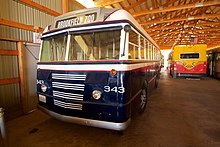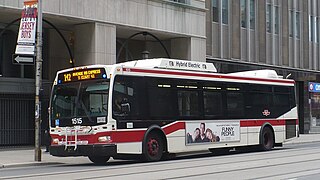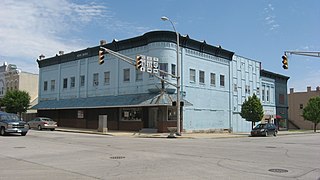
The Ford Country Squire is a series of station wagons that was assembled by American automaker Ford. The premium station wagon of the Ford division, the Country Squire was distinguished by its external woodgrain trim. Produced from the 1950 to 1991 model years, seven generations of the Country Squire were produced. Following the closure of Edsel, Mercury marketed the Mercury Colony Park as a divisional counterpart of the Country Squire, sharing bodywork and trim.
Kenworth is an American manufacturer of medium and heavy-duty Class 8 trucks with offices based in Kirkland, Washington, a suburb of Seattle. Kenworth is one of three major truck divisions and brands under parent company Paccar.
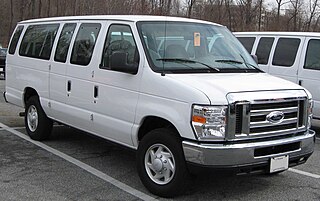
The Ford E series is a range of full-size vans produced by the American automaker Ford since 1960. Introduced for the 1961 model year as the replacement for the Ford F-series panel van, four generations of the model line have been produced. In addition to cargo van and passenger van body styles, the Ford E series has been produced as a cutaway van chassis and stripped chassis.

Checker Motors Corporation was a Kalamazoo, Michigan-based vehicle manufacturer and tier-one subcontractor that manufactured taxicabs used by Checker Taxi. Checker Motors Corporation was established by Morris Markin in 1922 through a merger of Commonwealth Motors and Markin Automobile Body.
Carpenter Body Works is a former American bus manufacturer. Founded in 1918 in Mitchell, Indiana, the company produced a variety of vehicles, with the majority of production consisting of yellow school buses for the United States and Canada.

FitzJohn was a bus manufacturer in Muskegon, Michigan. The company was founded October 8, 1919, by Harry Alphonse FitzJohn, and built over 5,000 bus bodies, complete buses, stretchout sedans and passenger-carrying trailers before closing down in May 1958.
Superior Coach is a former body manufacturer of the American automotive industry. Founded in 1909 as the Garford Motor Truck Company, Superior is best known for constructing bodies for professional cars (hearses) and yellow school buses. Following major downturns in both segments in the late 1970s, Superior was liquidated by its parent company in 1980. From 1925 to 1980, the company was based in Lima, Ohio.

The Crown Coach Corporation is a defunct American bus manufacturer. Established in 1904, Crown was headquartered in Los Angeles, California until the mid-1980s, moving to Chino, California until its closure. Best known for its Supercoach range of yellow school buses and motorcoaches, Crown also was the manufacturer of custom-built vehicles derived from its buses, including the Firecoach line of fire apparatus.

Albion Motors was a Scottish automobile and commercial vehicle manufacturer.
The Chevrolet and GMC B series is a series of cowled chassis that were produced by General Motors, primarily fitted with school bus bodies throughout its production. Based on the medium-duty trucks produced by the Chevrolet and GMC divisions of General Motors, the B series was produced in three separate generations; GMC initially produced its own version separate from Chevrolet. Introduced in 1966, the B series was redesigned in 1984 and 1992 as a 1993 model.

The Eagle was a make of motor coach with a long and interesting history. During a period of over four decades, some 8,000 Eagle coaches were built in four countries on two continents. The coaches were a common sight on American highways and were strongly associated with Continental Trailways for over three decades.
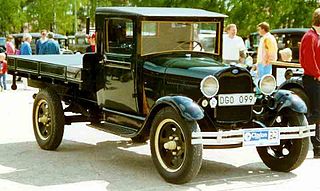
Ford Model AA is a truck from Ford. As the Model T and TT became obsolete and needed to be replaced, Henry Ford began initial designs on the Model A and Model AA in 1926. Basic chassis layout was done rapidly and mechanical development was moved forward quickly. Body design and style was developed and then outsourced to various body manufacturers, including Briggs and Murray. The designs of the Model A shared parts and materials with the Model AA Ford, notably the body, engine and interior. The AA usually received plainer interiors than their car counterparts. The Model AA followed similar design changes to the Model A during the AA's four years in production, often delayed anywhere from three to nine months. The mechanical changes and upgrades were done during production of the vehicles. Body changes that occurred between 1929 and 1930 were also integrated into AA production, but leftover parts were used longer in the heavy commercial trucks.

The Ford Thames 400E is a commercial vehicle that was made by Ford UK and introduced in 1957. Production of the range continued until September 1965, by which time a total of 187,000 had been built.
The SA was Toyota's first new passenger car design after World War II. It was the first in a family of vehicles before the introduction of the Crown. A series of light trucks also shared the chassis and major components of these passenger cars.

Canadian Military Pattern (CMP) trucks were a class and a coherent range of military trucks, made in large numbers, and in numerous variants, by Canada during World War II, compliant to British Army specifications, primarily intended for use in the armies of the British Commonwealth allies, but also serving in other units of the British Empire.

The Blue Bird All American is a bus produced by American bus manufacturer Blue Bird Corporation since 1948 in six different generations. While originally developed as a school bus, the All American has been marketed for a number of applications throughout its production, including the Blue Bird Wanderlodge luxury motorhome.
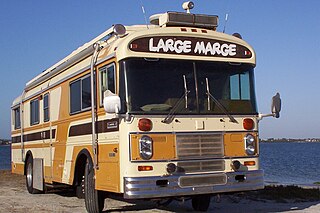
Wanderlodge is a high end brand of Class A motorhome recreational vehicle that was built by the Blue Bird Body Company in Fort Valley, Georgia, from about 1963 until 2009. Production started with a 31-foot (9.4 m) gasoline-powered forward control model and expanded to include larger diesel engine powered pusher models up to 45 feet (14 m) in length. They remain highly prized by their owners and have an extensive service network.

The Crown Supercoach is a bus that was constructed and marketed by Crown Coach Corporation from 1948 to 1991. While most examples were sold as yellow school buses, the Supercoach formed the basis for motorcoaches and other specialty vehicles using the same body and chassis. While technically available outside of the West Coast, nearly all Crown school buses were sold in California, Washington State, and Oregon.
The Wayne Lifestar is a product line of buses that was manufactured and marketed by Wayne Corporation and its successor company Wayne Wheeled Vehicles from 1986 to 1995. Produced nearly exclusively in a school bus configuration, the Wayne Lifestar used a transit-style body configuration with a front-engine chassis. Marking the return to transit-style production, the Lifestar adopted the single-piece body stampings of the Wayne Lifeguard in its construction.

In 1939 Dodge presented a completely new designed line of pickups and trucks, with streamlined, art-deco styling front sheetmetal. Introducing the concept of "Job- Rated", Dodge tried to offer customers the truck that fit the job they were buying it for. As a result, the Dodge pickup / truck range from 1939 onwards offered an exceptionally large number of available variants — six different payload ratings, a wide range of bodies, more than twenty different wheelbase-lengths were manufactured, and fitted with different sized versions of the Chrysler-sourced inline six-cylinder side-valve engines — from the half-ton TC pickup on a 116-inch wheelbase to three-ton tractor cabs. Nevertheless, mechanically, the trucks were all very similar, with solid axles front and rear and leaf springs at all four corners. With World War II taking up most of production capacity from 1942 to 1945, the 1939 styling continued largely unchanged through 1947, as engineering and production became the main focus.
